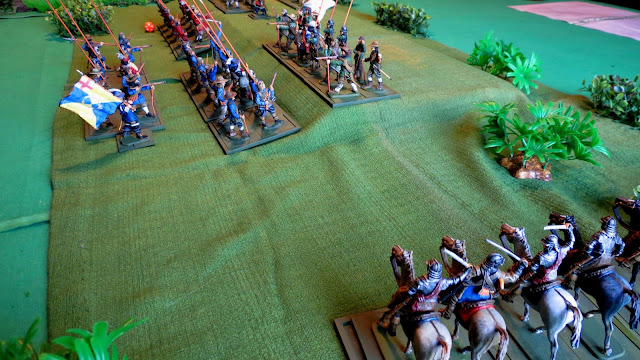Double Delay is the name of scenario no. 9 in One Hour Wargames, written by Neil Thomas, and it's the game that Anthony and I chose to play this weekend. In light of our previous experience using OHW we decided to use the full 6'x10' table, nine units per side instead of six and five troop types instead of four. We diced as normal for units to get a mix of infantry, cavalry, artillery and skirmishers then switched one unit of infantry for Guards (who use the Zouave profile from the ACW section of the book)
The British have occupied the town of San Antonio somewhere in the Peninsula, they are preparing to leave and rejoin the main army when the French appear on the horizon. They must delay the enemy and, if possible, deny them the town.
My poor old mother, God rest her soul, would have had forty fits if she'd seen what I've done to her finest Irish linen sheets. After several days of sponging and stippling they started to look like barren scrubland.
I was still painting the rocks at eight o'clock on the morning of the game, and they were still a bit wet when we were setting up! There's nothing like a deadline to get your productivity racing.
In true Wellsian fashion the toy soldiers all huddle behind hard cover to shelter from the enemy guns. They needn't have bothered, although the guns have a range covering virtually the whole table, their limited casualty effect means that troops in the open can take a hard pounding for some time before their capability becomes too seriously depleted. This is a good thing, it stops the guns dominating the game and reflects the effect of roundshot.
To add a bit of spice the British contingent included a band of Spanish Guerrillas (using the skirmisher unit profile) who act independently and can appear from any piece of cover or enter from any edge of the table at any time subject to the British player achieving an activation score of 6+ on a throw of 2xD6. Thus there's a good probability they'll appear on cue but it can't be taken for granted, here they emerge from the rocks to give the French artillery a nasty shock!
I take any opportunity to get this old Spanish town out for a game, I bought it for £10 at the very first Plastic Warrior Show,
(read about it here) I didn't really want it but it was destined to go in a skip if I hadn't taken it, also it had featured in Donald Featherstone's book "Skirmish Wargaming" (page 50) so I felt I had to save it.
French skirmishers scale the heights on the left of the field supported by the Guards and Chasseurs a Cheval, forcing the British artillery to retire.
The larger table size and additional units made for a lively game with lots of manoeuvre and three actions playing out: forcing the bridge on the left, the main assault against the town on the right and a fight to suppress the guerrillas in the rear centre. The poor marksmanship of the Guerrillas caused few problems for the French gunners but to contain them tied down an inordinate number of French infantry that could have been put to better use elsewhere, such is the purpose of these irregulars.
The river is a sectional model that clips together, made by Pegasus, it arrived in the nick of time the day before the game and went straight from box to table.
The French eventually took the town and pursued the British off the table, as the scenario required, we played the full 15 moves in about two and a half hours. I think we have found a formula that makes the OHW system work well for 54mm toy soldiers.




















































